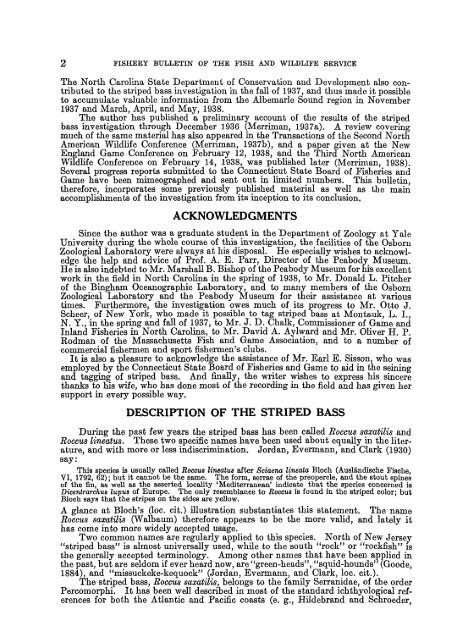Fishery bulletin of the Fish and Wildlife Service - NOAA
Fishery bulletin of the Fish and Wildlife Service - NOAA
Fishery bulletin of the Fish and Wildlife Service - NOAA
Create successful ePaper yourself
Turn your PDF publications into a flip-book with our unique Google optimized e-Paper software.
2 FISHERY BULLETIN OF THE FISH AND WILDLIFE SERVICE<br />
The North Carolina State Department <strong>of</strong> Conservation <strong>and</strong> Development also contributed<br />
to <strong>the</strong> striped bass investigation in <strong>the</strong> fall <strong>of</strong> 1937, <strong>and</strong> thus made it possible<br />
to accumulate valuable information from <strong>the</strong> Albemarle Sound region in November<br />
1937 <strong>and</strong> March, April, <strong>and</strong> May, 1938.<br />
The author has published a preliminary account <strong>of</strong> <strong>the</strong> results <strong>of</strong> <strong>the</strong> striped<br />
bass investigation through December 1936 (Merriman, 1937a). A review covering<br />
much <strong>of</strong> <strong>the</strong> same material has also appeared in <strong>the</strong> Transactions <strong>of</strong> <strong>the</strong> Second North<br />
American <strong>Wildlife</strong> Conference (Merriman, 1937b), <strong>and</strong> a paper given at <strong>the</strong> New<br />
Engl<strong>and</strong> Game Conference on February 12, 1938, <strong>and</strong> <strong>the</strong> Third North American<br />
<strong>Wildlife</strong> Conference on February 14, 1938, was published later (Merriman, 1938).<br />
Several progress reports submitted to <strong>the</strong> Connecticut State Board <strong>of</strong> <strong>Fish</strong>eries <strong>and</strong><br />
Game have been mimeographed <strong>and</strong> sent out in limited numbers. This <strong>bulletin</strong>,<br />
<strong>the</strong>refore, incorporates some previously published material as well as <strong>the</strong> main<br />
accomplishments <strong>of</strong> <strong>the</strong> investigation from its inception to its conclusion.<br />
ACKNOWLEDGMENTS<br />
Since <strong>the</strong> author was a graduate student in <strong>the</strong> Department <strong>of</strong> Zoology at Yale<br />
University during <strong>the</strong> whole course <strong>of</strong> this investigation, <strong>the</strong> facilities <strong>of</strong> <strong>the</strong> Osboru<br />
Zoological Laboratory were always at his disposal. He especially wishes to acknowledge<br />
<strong>the</strong> help <strong>and</strong> advice <strong>of</strong> Pr<strong>of</strong>. A. E. Parr, Director <strong>of</strong> <strong>the</strong> Peabody Museum.<br />
He is also indebted to Mr. Marshall B. Bishop <strong>of</strong> <strong>the</strong> Peabody Museum for his excellent<br />
work in <strong>the</strong> field in North Carolina in <strong>the</strong> spring <strong>of</strong> 1938, to Mr. Donald L. Pitcher<br />
<strong>of</strong> <strong>the</strong> Bingham Océanographie Laboratory, <strong>and</strong> to many members <strong>of</strong> <strong>the</strong> Osborn<br />
Zoological Laboratory <strong>and</strong> <strong>the</strong> Peabody Museum for <strong>the</strong>ir assistance at various<br />
times. Fur<strong>the</strong>rmore, <strong>the</strong> investigation owes much <strong>of</strong> its progress to Mr. Otto J.<br />
Scheer, <strong>of</strong> New York, who made it possible to tag striped bass at Montauk, L. I.,<br />
N. Y., in <strong>the</strong> spring <strong>and</strong> fall <strong>of</strong> 1937, to Mr. J. D. Chalk, Commissioner <strong>of</strong> Game <strong>and</strong><br />
Inl<strong>and</strong> <strong>Fish</strong>eries in North Carolina, to Mr. David A. Aylward <strong>and</strong> Mr. Oliver H. P.<br />
Rodman <strong>of</strong> <strong>the</strong> Massachusetts <strong>Fish</strong> <strong>and</strong> Game Association, <strong>and</strong> to a number <strong>of</strong><br />
commercial fishermen <strong>and</strong> sport fishermen's clubs.<br />
It is also a pleasure to acknowledge <strong>the</strong> assistance <strong>of</strong> Mr. Earl E. Sisson, who was<br />
employed by <strong>the</strong> Connecticut State Board <strong>of</strong> <strong>Fish</strong>eries <strong>and</strong> Game to aid in <strong>the</strong> seining<br />
<strong>and</strong> tagging <strong>of</strong> striped bass. And finally, <strong>the</strong> writer wishes to express his sincere<br />
thanks to ms wife, who has done most <strong>of</strong> <strong>the</strong> recording in <strong>the</strong> field <strong>and</strong> has given her<br />
support in every possible way.<br />
DESCRIPTION OF THE STRIPED BASS<br />
During <strong>the</strong> past few years <strong>the</strong> striped bass has been called Roccus saxatilis <strong>and</strong><br />
Roccus lineatus. These two specific names have been used about equally in <strong>the</strong> literature,<br />
<strong>and</strong> with more or less indiscrimination. Jordan, Evermann, <strong>and</strong> Clark (1930)<br />
say:<br />
This species is usually called Roccus lineatus after Sciaena lineata Bloch (Ausländische Fische,<br />
VI, 1792, 62) ; but it cannot be <strong>the</strong> same. The form, serrae <strong>of</strong> <strong>the</strong> preopercle, <strong>and</strong> <strong>the</strong> stout spines<br />
<strong>of</strong> <strong>the</strong> fin, as well as <strong>the</strong> asserted locality 'Mediterranean' indicate that <strong>the</strong> species concerned is<br />
Dicentrarchus lupus <strong>of</strong> Europe. The only resemblance to Roccus is found in <strong>the</strong> striped color; but<br />
Bloch says that <strong>the</strong> stripes on <strong>the</strong> sides are yellow.<br />
A glance at Bloch's (loc. cit.) illustration substantiates this statement. The name<br />
Roccus saxatilis (Walbaum) <strong>the</strong>refore appears to be <strong>the</strong> more valid, <strong>and</strong> lately it<br />
has come into more widely accepted usage.<br />
Two common names are regularly applied to this species. North <strong>of</strong> New Jersey<br />
"striped bass" is almost universally used, while to <strong>the</strong> south "rock" or "rockfish" is<br />
<strong>the</strong> generally accepted terminology. Among o<strong>the</strong>r names that have been applied in<br />
<strong>the</strong> past, but are seldom if ever heard now, are "green-heads", "squid-hounds" (Goode,<br />
1884), <strong>and</strong> "missuckeke-kequock" (Jordan, Evermann, <strong>and</strong> Clark, loc. cit.).<br />
The striped bass, Roccus saxatilis, belongs to <strong>the</strong> family Serranidae, <strong>of</strong> <strong>the</strong> order<br />
Percomorphi. It has been well described in most <strong>of</strong> <strong>the</strong> st<strong>and</strong>ard ichthyological references<br />
for both <strong>the</strong> Atlantic <strong>and</strong> Pacific coasts (e. g., Hildebr<strong>and</strong> <strong>and</strong> Schroeder,

















